Trump made his move—then pulled back. After weeks of tough talk, he paused the planned 25% tariffs on Mexico and Canada for 30 days. But this wasn’t a sign of compromise. It was a calculated trade-off. Mexico agreed to deploy 10,000 troops to its northern border. Canada pledged $1.3 billion to tighten enforcement.
It’s a temporary truce, not a peace deal. The tariffs on China remain in full force, and history shows that when Trump starts a trade war, he doesn’t stop at one front. The next targets are already lining up—and they might not even see it coming.
But why is fentanyl—an opioid crisis destroying American communities—suddenly at the center of global trade disputes? What does a deadly drug have to do with customs tariffs? And why is Trump pointing the finger at Mexico, Canada, and China?
Why Trump wants Ukraine’s Rare Earths? the Hidden Truth Unearthed – Part 1 (feat. apple iPhone, steve jobs)
Why Trump Is Attacking China with Tariffs: Hidden Agenda
Why Is Trump Targeting Canada and Mexico? (Feat. China, fentanyl, Tariffs)
Jensen Huang’s Secret Meeting with Trump (Feat. Deepseek, NVIDIA, China, USA, Open AI Chat GPT)
1. The official reason behind Trump’s tariff push on Canada and Mexico is Fentanyl control and stricter border enforcement.
2. Fentanyl is a powerful opioid painkiller originally developed by Belgian pharmaceutical giant Janssen.


3. This drug’s molecular structure allows it to rapidly penetrate the brain(BBB, brain-blood-barrier), making it incredibly potent.
4. Its painkilling effect is over 100 times stronger than morphine, ranking it among the most potent pain relievers in history.
5. Because of its potency, fentanyl is widely used for terminal cancer patients and hospice care.
6. But it’s also highly toxic—100 times deadlier than cyanide. Just 2 milligrams can be fatal.

7. The human body feels distress when carbon dioxide (CO₂) levels rise in the blood.
8. Contrary to popular belief, we don’t breathe because of low oxygen—we breathe because our CO₂ levels trigger the brain to act.
9. Fentanyl shuts down the body’s CO₂ detection system, making people unaware they’re suffocating.
10. This means users stop breathing without feeling discomfort, leading to silent, rapid overdoses.
11. If fentanyl accumulates in the brain, it can cause severe hypoxia, leading to permanent brain damage or death.
12. In high doses, fentanyl completely paralyzes the central nervous system, stopping breathing altogether.
13. Many victims are found curled up in a position resembling drowning, a telltale sign of fentanyl-induced oxygen deprivation.
14. Because it induces a zombie-like, frozen state, fentanyl is often nicknamed the “zombie drug.”

15. In 1981, fentanyl’s patent expired, opening the door for cheap, widespread production.
16. Prices plummeted, and fentanyl flooded the global market.
17. A 2 pounds of fentanyl can produce enough doses to get a million people high.
18. Its low manufacturing cost makes it the most widely abused opioid in the U.S. today.
19. Most of the raw materials used to make fentanyl are produced in China.

20. While China has strict anti-drug laws, it still dominates the global fentanyl supply chain.
21. Instead of making fentanyl directly, China exports raw chemicals to Mexican drug cartels, disguising them as legal chemical products.
22. These cartels then manufacture fentanyl in secret labs and smuggle it across the U.S.-Mexico border, supplying 85% of America’s illegal fentanyl.
23. This is why the U.S. has named China, Mexico, and Canada as primary trade targets, pressuring them to crack down on fentanyl trafficking.

24. The U.S. Congress believes that China intentionally allows fentanyl exports to weaken Western countries.
25. Reports show Chinese traffickers are the biggest fentanyl suppliers in the U.S., often selling the drug disguised as health supplements on platforms like Alibaba.
26. Because of China’s central role in fentanyl production, U.S. officials have nicknamed it “China White.”

27. Fentanyl’s biggest danger is at Its ease of use.
28. Unlike heroin, fentanyl doesn’t require injections—it can be absorbed through the skin or mucous membranes.
29. People have been caught coating dollar bills in fentanyl powder and folding them for easy transport and use.
30. Fentanyl is now the leading cause of death in the U.S., surpassing suicide, car accidents, and gun violence.
31. Now, fentanyl is the #1 cause of death for Americans aged 18-49.


32. Around 1.2 million American workers have dropped out of the labor force due to opioid addiction, hurting the economy.
33. 65% of fentanyl deaths occur among prime working-age adults (25-54 years old).

34. Meanwhile, Trump is ramping up efforts to deport illegal immigrants.
35. To compensate for labor shortages, he wants to reduce workforce losses caused by fentanyl addiction.
36. But there’s another angle to these tariffs—bringing manufacturing jobs back to America.
37. Revitalizing U.S. manufacturing has been a core Trump strategy since his first term.
38. In Trump’s first presidency, he successfully replaced NAFTA with a new trade deal—USMCA.
39. At the heart of this is automobile manufacturing—a major job creator.

40. The auto industry relies on a massive supply chain, involving thousands of parts suppliers.
41. Companies exploited U.S.-Mexico free trade by manufacturing parts in Mexico and only assembling vehicles in the U.S.
42. Automakers set up factories along the Mexico-U.S. border, taking advantage of low wages.
43. While U.S. auto workers make $22/hour, Mexican workers earn just $3.50/hour—a huge labor cost gap.
44. Even with higher transport costs, it was still cheaper to produce in Mexico and ship parts to the U.S.

45. Trump’s NAFTA renegotiation forced Mexico to raise wages for auto workers in an attempt to move production back to the U.S.
46. Under USMCA, 45% of car parts must now be made by workers earning at least $16/hour.
47. Translation? Automakers were pushed to hire more American workers.
48. Trump’s goal was clear—force car companies to relocate production back to the U.S.
49. But the higher wages raised costs, making American cars more expensive.

50. As a result, foreign automakers from Europe, Japan, and South Korea gained an unexpected advantage.
51. To counter this, Trump proposed a 25% tariff on foreign-made cars, trying to level the playing field.
52. Meanwhile, USMCA also raised the North American content requirement from 62.5% to 75%, forcing companies to source more parts locally.
53. Trump sees this as a model trade success—and he is now demanding further revisions in his second term.
54. One of the biggest concerns for foreign automakers is Trump’s potential revival of a blanket tariff on imported cars, a move he previously attempted but never fully enforced.
55. In response, many automakers are expanding U.S. production to stay competitive and avoid potential tariffs.
56. One of the key cost factors for car manufacturing is steel prices.
57. The U.S. has higher labor costs but benefits from low electricity and natural gas prices, making local production more viable under the right conditions.
58. This is why some Asian manufacturers are now considering building steel plants in the U.S. to strengthen their cost competitiveness.

59. Trump’s slower push for electric vehicle adoption also ties into this strategy.
60. Unlike traditional gas-powered cars, EVs require fewer parts and suppliers, meaning fewer American jobs in the auto industry.
61. Given the focus on job creation, Trump may seek to extend the lifespan of gas-powered car production in the U.S. until a new economic framework is established.
62. On January 27, The Wall Street Journal first reported that Trump was preparing to impose a 25% tariff on imports from Mexico and Canada starting February 1.
63. Initially, analysts speculated that Trump’s tariff threats were just a negotiation tactic—but now, the situation is developing differently.
64. With Trump gaining momentum after forcing Colombia to concede on trade, he may take a “tariffs first, negotiate later” approach with Mexico and Canada.
65. While the official rationale is stopping fentanyl and illegal immigration, the real target appears to be another round of USMCA renegotiations.
66. Canada has limited leverage in a trade war since the U.S. can easily substitute Canadian exports like lumber, oil, and food with domestic production.
67. However, Canada depends heavily on the U.S., with over 75% of its exports going to the American market—so any tariffs could deal a serious blow to its economy.
68. Meanwhile, Trump is likely to target Chinese investments in Mexico as part of his trade policy.
69. Around 20% of recent foreign investment in Mexico has come from Chinese companies, many of which use Mexico as a backdoor to export to the U.S.
70. Beyond drug and immigration control, Trump will likely demand Mexico curb Chinese investments before lifting tariffs.

Alphazen insights

Trump dominated Colombia, and now, as expected, Mexico and Canada are next. But they won’t be the only ones feeling the heat. Other countries with stakes in Mexico are watching closely. No one wants to be the next test case. As nations tread carefully, Trump is only gaining momentum.
Discover more from Alphazen Dynamics
Subscribe to get the latest posts sent to your email.






